Hyundai I20 N Series Specs
Motor Vehicle
Motor vehicle
| Hyundai i20 | |
|---|---|
 Hyundai i20 (BC3) | |
| Overview | |
| Manufacturer | Hyundai |
| Production | 2008–present |
| Body and chassis | |
| Class | Supermini (B) |
| Layout | Front-engine, front-wheel-drive |
| Chronology | |
| Predecessor | Hyundai Getz |
The Hyundai i20 is a supermini hatchback produced by Hyundai since 2008. The i20 made its debut at the Paris Motor Show in October 2008, and sits between the i10 and i30. The i20 replaces the Getz in nearly all of its markets, while several markets received the slightly larger Accent/Verna hatchback to replace it instead.
Currently, the largest markets for the i20 are Europe and India, with two models being developed to cater each market.
First generation (PB; 2008) [edit]
Motor vehicle
| First generation (PB/PBT) | |
|---|---|
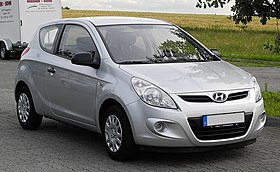 | |
| Overview | |
| Production | 2008–2014 2008–2015 (India)[1] |
| Assembly | Turkey: İzmit (HAOS)[2] India: Chennai (HMIL) |
| Designer | Thomas Bürkle[3] |
| Body and chassis | |
| Body style | 3-door hatchback 5-door hatchback |
| Platform | Hyundai-Kia PB |
| Related |
|
| Powertrain | |
| Engine |
|
| Transmission | 5-speed manual 6-speed manual 4-speed automatic |
| Dimensions | |
| Wheelbase | 2,525 mm (99.4 in) |
| Length | 3,940–3,995 mm (155.1–157.3 in) |
| Width | 1,710 mm (67.3 in) |
| Height | 1,490 mm (58.7 in) |
The Hyundai i20 uses a completely new platform that was created at Hyundai's European technical centre in Rüsselsheim to allow Hyundai to move into Europe's highly competitive subcompact B segment. A 2,525 mm (99.4 in) wheelbase helps endow the i20 with a generous passenger cabin. Suspension follows the supermini norm of MacPherson struts at the front and a torsion beam rear end, with rack and pinion steering.
A slightly upgraded version of the i20, called the iGen i20, went on sale in India in March 2012 onward with tweaked headlamps, new front grille, tail lamps and fog lamps. It follows the "Fluidic Sculpture" design philosophy with slightly retuned engines. A new next generation model, known as Elite i20 in India, was launched in India on 11 August 2014 and in Europe in the 2014 Paris Motor Show.[4] [5]
The i20 was not sold in South Korea, North America and the Philippines as those markets have the Accent. The i20 was discontinued in the Indonesian market in 2012 due to the introduction of the Accent hatchback, which is known there as the Grand Avega.[6]
The i20 was produced in Sriperumbudur (near Chennai), India for sale in Asia[7] and Oceania,[8] and later was also assembled in Turkey (İzmit plant) for the European market by CKD kits from India.[9]
-
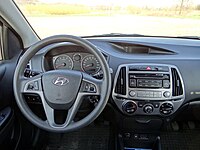
Facelift interior
-
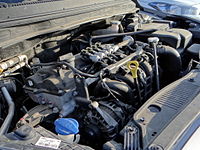
Engine bay
Engines [edit]
The i20 has a total of seven four cylinder engine options. Four are petrol, including the 1248 cc dohc 16 valve "Aditeya" engine,[ clarification needed ] while the rest are diesel engines. Two of the diesel engines are 1396 cc units, one with 75 PS (55 kW; 74 hp) and 220 N⋅m (160 lb⋅ft) and the other a 90 PS (66 kW; 89 hp) and 220 N⋅m (160 lb⋅ft) high power unit.
They are joined by two 1582 cc engines having the same dohc and 16 valve top end architecture, but delivering either 115 PS (85 kW; 113 hp) and 156 N⋅m (115 lb⋅ft) of torque or 128 PS (94 kW; 126 hp) and 157 N⋅m (116 lb⋅ft) of torque.
Hyundai claims that 115 PS (85 kW; 113 hp) diesel unit can return a class leading 115g/km of CO2 per litre of diesel to go 23.25 km/L (65.7 mpg‑imp; 54.7 mpg‑US) (4.3L/100 km) in the European combined driving cycle.[ citation needed ] All diesel engines and 1.2-litre and 1.4-litre petrol engines come mated to five speed manual transmission, there is an option of a four speed automatic for some 1.4-litre petrol engined models, the 1.6-litre is mated to a six speed manual transmission.
In the Indian market, the Hyundai i20 is powered by a 1.2-litre Kappa engine with 80 PS (59 kW; 79 hp) power at 5200 rpm and 114 N⋅m (84 lb⋅ft) torque at 4,000 rpm. It also comes with a 1.4-litre gamma gasoline which has 100 PS (74 kW; 99 hp) power at 5500 rpm and 139 N⋅m (103 lb⋅ft) torque at 4200 rpm, but is mated only to a four speed automatic transmission. The i20 CRDi diesel has 90 PS (66 kW; 89 hp) at 4000 rpm and 224 N⋅m (165 lb⋅ft) torque between 1750 and 2750 rpm, and comes with a six speed manual transmission.[10]
In Australia, the i20 was originally offered as a 1.4 petrol with a $3500 option of the Gamma II G4FC 1.6 petrol engine. The 1.6 makes 91 kW at 6300rpm and 157Nm at 4200rpm. However, with the arrival of the new 1.6 powered Accent in the end of 2011, the 1.6L option on the i20 has been dropped.
In South Africa, the i20 was originally offered in 2009 with either 1.4 (G4FA) or 1.6 (G4FC) engines, with the 1.4 having an optional 4 speed automatic transmission. The facelift model was introduced in the second half of 2012[11] with only the 1.4 gamma engine initially being offered (the 1.6 engine was discontinued), after which a 1.2 kappa engine, a 1.4 CRDi engine as well as a new 6 speed manual transmission for some 1.4 models was added to the range.[12]
Safety [edit]
The Hyundai i20 earned a maximum five star safety rating from Euro NCAP[14] and scored six out of a maximum of seven points in the "safety assist" category, receiving top marks for its belt reminder and electronic stability programme which minimises the risk of skidding by braking individual wheels.[15] The i20 was named one of Euro NCAP's "top five safest cars for 2009", which was based on Euro NCAP's maximum five star awards and their overall score.[16]
The Hyundai i20 features starts with six airbags—for driver and passenger in the front along with side and curtain airbags for rear passengers, whilst the Antilock Brake System (ABS) with Electronic Brake-force Distribution (EBD) which helps to control in slippery surfaces.
Hyundai i20 has new additions in its safety features like rain sensing wipers and automatic darkness sensing headlamps, central locking, impact sensing auto door unlock, keyless entry along with front and rear fog lamps and advanced engine immobilizer.
Gallery [edit]
Pre-facelift styling
-

Front (3-door)
-
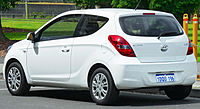
Rear (3-door)
-

Front (5-door)
-

Rear (5-door)
Post-facelift styling
-

Front (3-door)
-

Rear (3-door)
-

Front (5-door)
-
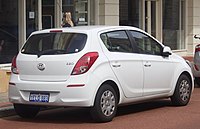
Rear (5-door)
Second generation (GB/IB; 2014) [edit]
Motor vehicle
| Second generation (GB/IB) | |
|---|---|
 | |
| Overview | |
| Also called | Hyundai Elite i20 (India, IB) |
| Production | 2014–2020 |
| Assembly |
|
| Designer | Casey Hyun |
| Body and chassis | |
| Body style |
|
| Platform | Hyundai-Kia GB (GB) Hyundai-Kia PB (IB) |
| Related |
|
| Powertrain | |
| Engine |
|
| Transmission |
|
| Dimensions | |
| Wheelbase | 2,570 mm (101.2 in) |
| Length | 4,035 mm (158.9 in) 3,985 mm (156.9 in) (IB) |
| Width | 1,734 mm (68.3 in) |
| Height | 1,474 mm (58.0 in) |
| Chronology | |
| Successor | Hyundai Bayon (i20 Active) |
The second generation Hyundai i20 supermini has a new exterior and interior design, and a new 1.4-litre diesel engine.
It was launched in August 2014 in India,[18] and in November 2014 in Europe.[19] The design of the car employs Hyundai's 'Fluidic Sculpture 2.0' design philosophy.[20] The design for the car has been developed at Hyundai's design facilities in Rüsselsheim, Germany.
Some of the design features of the new i20 include trapezoidal fog lamps, black C pillar block, wrap around tail lamps, re worked headlights and the hexagonal front grille. The interiors feature a black and beige dual tone dashboard, multi-steering-mounted audio controls, Bluetooth integrated 2 DIN audio with USB and Aux inputs with 1 GB internal storage, rear AC vents, a dedicated engine start/stop button, and automatic temperature control.[21]
In order to match the pricing of its key competitor, Hyundai has introduced a refreshed i20 with new prices and features cut for 2017.[22]
-

Rear view (5-door)
-

Hyundai i20 Coupe
-

Hyundai i20 Coupe
India (Elite i20; IB) [edit]
The second generation i20 was launched in August 2014 in India as the Elite i20. It eventually won the 2015 Indian Car Of The Year (ICOTY) in December 2014.[23] At launch, ten variants and two engine options are offered in the market. The car also has a higher ground clearance than before, 170 mm as against 165 mm of the old i20. The i20 has 326 litres of boot space.
The i20 is powered by 1.2-litre Kappa Dual VTVT petrol engine and 1.4-litre U2 CRDi diesel engine.[24] The hatchback has safety features such as ABS, dual front airbags and seat belt pretensioners as standard while rear camera with EOM display, headlamp escort function, reverse parking sensors and six airbags are available in higher variants.[25]
Facelift [edit]
Launched at the 2018 Auto Expo in India, the car features new front and rear bumpers, new boot lid which now also included rear number plate slot, moved from the rear bumper, and a new tail lamp design. Changes to the interior including the addition of a new infotainment system equipped with Apple CarPlay and Android Auto. The 4-speed torque converter automatic transmission was replaced with a CVT for petrol engine variants.
-
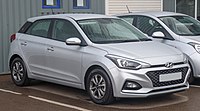
Hyundai i20 (GB; facelift)
-

Hyundai i20 (GB; facelift)
-

Interior (facelift)
i20 Active [edit]
A crossover-styled variant called the i20 Active, was launched in India on 17 March 2015 and in Europe at the Frankfurt Motor Show in September 2015.[26] It features front, rear and side black plastic cladding, along with roof rails, rugged-looking fuel cap, and both front and rear aluminum skid plates. The i20 Active also gets cornering lamps, aluminum pedals and roof rails, along with a fuel lid cover. The ground clearance of the Indian-spec i20 Active has been increased to 190 mm, which is a 20 mm gain over the standard i20 at 170 mm.
-
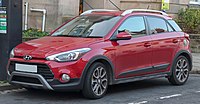
Hyundai i20 Active (GB; pre-facelift)
-

Hyundai i20 Active (GB; pre-facelift)
Powertrain [edit]
GB models [edit]
| Model | Year | Transmission | Power | Torque | 0–100 km/h (0-62 mph) (official) | Top speed (km/h) (official) |
|---|---|---|---|---|---|---|
| 1.0 L Kappa T-GDi (100 PS) | 2014–2020 | 5-speed manual 7-speed DCT | 100 PS (74 kW; 99 hp) @ 4,500 rpm | 17.5 kg⋅m (172 N⋅m; 127 lbf⋅ft) @ 1,500-4,000 rpm |
|
|
| 1.0 L Kappa T-GDi (120 PS) | 6-speed manual | 120 PS (88 kW; 118 hp) @ 6,000 rpm | 10.2 s | 190 km/h (118 mph) | ||
| 1.25 L Kappa MPi | 5-speed manual | 75 PS (55 kW; 74 hp) @ 5,500 rpm 84 PS (62 kW; 83 hp) @ 6,000 rpm | 12.4 kg⋅m (122 N⋅m; 90 lbf⋅ft) @ 4,000 rpm |
|
| |
| 1.4 L Kappa MPi | 6-speed manual 4-speed automatic | 100 PS (74 kW; 99 hp) @ 6,000 rpm | 13.7 kg⋅m (134 N⋅m; 99 lbf⋅ft) @ 3,500 rpm |
|
| |
| 1.1 L U2 CRDi | 6-speed manual | 75 PS (55 kW; 74 hp) @ 4,000 rpm | 18.3 kg⋅m (179 N⋅m; 132 lbf⋅ft) @ 1,750-2,500 rpm | 15.7 s | 161 km/h (100 mph) | |
| 1.4 L U2 CRDi | 90 PS (66 kW; 89 hp) @ 4,000 rpm | 24.5 kg⋅m (240 N⋅m; 177 lbf⋅ft) @ 1,500-2,500 rpm | 12.1 s | 175 km/h (109 mph) |
IB models [edit]
| Model | Year | Transmission | Power | Torque | 0–100 km/h (0-62 mph) (official) | Top speed (km/h) (official) |
|---|---|---|---|---|---|---|
| 1.2 L Kappa MPi | 2014–2020 | 5-speed manual CVT | 82 PS (60 kW; 81 hp) @ 6,000 rpm | 11.7 kg⋅m (115 N⋅m; 85 lbf⋅ft) @ 4,000 rpm | ||
| 1.4 L Kappa MPi | 6-speed manual 4-speed automatic | 100 PS (74 kW; 99 hp) @ 6,000 rpm | 13.7 kg⋅m (134 N⋅m; 99 lbf⋅ft) @ 3,500 rpm |
|
| |
| 1.4 L U2 CRDi | 6-speed manual 4-speed automatic | 90 PS (66 kW; 89 hp) @ 4,000 rpm | 24.5 kg⋅m (240 N⋅m; 177 lbf⋅ft) @ 1,500-2,500 rpm | 12.1 s | 175 km/h (109 mph) |
Third generation (BC3/BI3; 2020) [edit]
Motor vehicle
| Third generation (BC3/BI3) | |
|---|---|
 | |
| Overview | |
| Production | 2020–present |
| Assembly |
|
| Body and chassis | |
| Body style | 5-door hatchback |
| Platform | Hyundai-Kia K2 |
| Related | Hyundai Bayon Hyundai Venue Hyundai Creta (SU2) Hyundai Accent/Verna (HC) |
| Powertrain | |
| Engine |
|
| Transmission |
|
| Dimensions | |
| Wheelbase | 2,580 mm (101.6 in) |
| Length | 4,040 mm (159.1 in) (BC3) 3,995 mm (157.3 in) (BI3) |
| Width | 1,750 mm (68.9 in) (BC3) 1,775 mm (69.9 in) (BI3) |
| Height | 1,450 mm (57.1 in) (BC3) 1,505 mm (59.3 in) (BI3) |
| Curb weight | 1,013–1,225 kg (2,233–2,701 lb)[27] |

The third-generation i20 was unveiled online for the European market on 19 February 2020. It was supposed to debut at the 90th Geneva Motor Show in March 2020, but the show and the launch were cancelled due to the COVID-19 pandemic.
The third generation i20 is larger and lower than the previous generation, its design is now employs Hyundai's latest "Sensuous Sportiness" design philosophy, featuring a redesigned exterior and interior styling.
Markets [edit]
Europe (BC3) [edit]
After its debut in February 2020, production for the European market commenced in the Izmit plant in Turkey in August 2020.[28] The plant will produce around 85,000 units of i20 per year, covering about 50% of the global i20 production.[29]
The top spec is equipped two 10.25-inch displays – one for the instrument gauge cluster and one for the main infotainment display.[30] It is also available with an N Line trim and N performance-oriented variant.
In 2021, Hyundai launches France-only i20 N Line Michel Vaillant limited edition, featuring optional blue and red stickers..[31]
India (BI3) [edit]
The third-generation i20 was launched in the country on 5 November 2020. It dropped the "Elite" prefix from the previous generation, now simply marketed as the "Hyundai i20". The Indian-market i20, codenamed BI3, is 45 mm (1.8 in) shorter than the European version to circumvent Indian tax bracket which favours vehicles shorter than 4,000 mm (157.5 in), while it is 25 mm (1.0 in) wider and 55 mm (2.2 in) taller.[32] It is built on the Hyundai-Kia K2 platform shared with other Hyundai-Kia recent compact cars. It is claimed to makes use of 66 percent high-strength steel which improves its crash safety.[33]
On 24 August 2021, Hyundai introduced the N Line variant for the BI3 i20.[34] [35]
-

Hyundai i20 (BI3; India)
-

Hyundai i20 (BI3; India)
-

Hyundai i20 N Line (BI3; India)
-

Interior (BI3)
i20 N [edit]
A performance version called the i20 N was revealed for the European market in October 2020.[36] It slots under the i30 N in the Hyundai N family.
The i20 N is powered by a 1.6-liter turbocharged GDi engine mated to a 6-speed manual transmission. This engine is good for 201 hp (204 PS; 150 kW) and 275 N⋅m (28.0 kg⋅m; 203 lb⋅ft) of torque. As the i20 N only weighs 1,190 kg (2,620 lb), it is able to accelerate from 0–100 km/h (0–62 mph) in a 6.2 seconds with a top speed of 230 km/h (143 mph).[37]
Its engine delivers peak torque between 1,750 and 4,500 rpm and hits peak power between 5,500 and 6,000 rpm. The broad power band helps its acceleration performance throughout the mid and high-speed range. Although the Gamma engine is featured in other Hyundai models, for the i20 N it is equipped with a bespoke turbocharger and intercooler system.
Changes also include a reinforced the chassis at 12 different points, and a reinforced front domes and knuckles with distinct geometry for the suspension. The camber has also been increased while a new sway bar, new springs, and new shock absorbers have been fitted. The brakes have also been enlarged.[38]
-

Hyundai i20 N
-

Rear view
-

Interior
Powertrain [edit]
BC3 models [edit]
| Model | Year | Transmission | Power | Torque | 0–100 km/h (0-62 mph) (official) | Top speed |
|---|---|---|---|---|---|---|
| Petrol engines | ||||||
| 1.0 L Smartstream G1.0 T-GDi (100 PS) | 2020–present | 6-speed manual 7-speed DCT | 100 PS (74 kW; 99 hp) @ 4,500–6,000 rpm | 17.5 kg⋅m (172 N⋅m; 127 lbf⋅ft) @ 1,500–4,000 rpm |
|
|
| 1.0 L Smartstream G1.0 T-GDi (120 PS) | 6-speed manual | 120 PS (88 kW; 118 hp) @ 6,000 rpm | 17.5 kg⋅m (172 N⋅m; 127 lbf⋅ft) @ 1,500–4,000 rpm | 10.1 s | 190 km/h (118 mph) | |
| 7-speed DCT | 20.4 kg⋅m (200 N⋅m; 148 lbf⋅ft) @ 2,000–3,000 rpm | 10.3 s | ||||
| 1.2 L Smartstream G1.2 MPi | 5-speed manual | 84 PS (62 kW; 83 hp) @ 6,000 rpm | 12.4 kg⋅m (122 N⋅m; 90 lbf⋅ft) @ 4,000 rpm | 13.1 s (manual) | 173 km/h (107 mph) | |
| 1.6 L Smartstream G1.6 T-GDi (i20 N) | 6-speed manual | 204 PS (150 kW; 201 hp) @ 6,000 rpm | 28 kg⋅m (275 N⋅m; 203 lbf⋅ft) @ 1,500–4,500 rpm | 6.2 s | 230 km/h (143 mph) | |
BI3 models [edit]
| Model | Year | Transmission | Power | Torque |
|---|---|---|---|---|
| Petrol engines | ||||
| 1.0 L Kappa II T-GDi | 2020–present | 6-speed clutchless manual 7-speed DCT | 120 PS (88 kW; 118 hp) @ 6,000 rpm | 17.5 kg⋅m (172 N⋅m; 127 lbf⋅ft) @ 1,500–4,000 rpm |
| 1.2 L Kappa II MPi | 5-speed manual | 83 PS (61 kW; 82 hp) @ 6,000 rpm | 11.7 kg⋅m (115 N⋅m; 85 lbf⋅ft) @ 4,200 rpm | |
| CVT | 88 PS (65 kW; 87 hp) @ 6,000 rpm | |||
| Diesel engine | ||||
| 1.5 L U II CRDi | 2020–present | 6-speed manual | 100 PS (74 kW; 99 hp) @ 4,000 rpm | 24.5 kg⋅m (240 N⋅m; 177 lbf⋅ft) @ 1,500–2,750 rpm |
Sales [edit]
| Calendar year | Europe[39] | India |
|---|---|---|
| 2008 | 785 | |
| 2009 | 58,416 | 31,122[40] |
| 2010 | 68,087 | 71,849[41] |
| 2011 | 80,917 | 80,571[42] |
| 2012 | 75,343 | 85,299[43] |
| 2013 | 82,139 | 71,788[43] |
| 2014 | 83,903 | 69,116[44] |
| 2015 | 91,758 | 130,085[45] |
| 2016 | 98,956 | 122,489[46] |
| 2017 | 100,571 | 134,103[47] |
| 2018 | 91,272 | 141,104[48] |
| 2019 | 84,218 | 123,201[49] |
| 2020 | 63,301 | 73,414[50] |
Motorsport [edit]

The Hyundai i20 WRC is a World Rally Car built by Hyundai for use in the 2014 World Rally Championship.[51] It is based on the i20, and was unveiled at the 2012 Paris Motor Show, marking Hyundai's return to the WRC after a ten-year absence.[52] The car will be operated by Hyundai's performance division, Hyundai Motorsport from a base in Frankfurt, Germany.[53]
The i20 WRC made its debut at the Monte Carlo Rally in January 2014.[54]
From 2017 onwards Hyundai i20 Coupe WRC is used in World Rally Championship.
Hyundai i20 R5 is used in World Rally Championship-2 competitions.
Two cars were entered into 2018 FIA World Rallycross Championship, with Niclas Grönholm finishing 7th overall. Four cars were entered in 2019, with Timur Timerzyanov winning in Belgium.
Hyundai i20 Coupe WRC is the current manufacturers' championship leader in 2019 World Rally Championship built by Hyundai Shell Mobis WRT[55] [56]
References [edit]
- ^ Costello, Mike (2 December 2014). "New-generation Hyundai i20 in doubt for Australia". CarAdvice. Retrieved 8 May 2016.
- ^ "Hyundai confirms i20 for Izmit plant". Uibrussia.org. Archived from the original on 26 August 2014. Retrieved 7 February 2011.
- ^ "Thomas Bürkle". Hyundai Motor UK Ltd. Archived from the original on 2 October 2013. Retrieved 12 August 2013.
- ^ Shivank Bhatt. "Hyundai's all-new Elite i20 launched at Rs 4.90 lakh". Gaadi.com. Retrieved 11 August 2014.
- ^ Noah Joseph. "Hyundai reveals new i20 hatchback ahead of Paris debut". autoblog.com. Retrieved 29 September 2014.
- ^ "Hyundai Indonesia Pensiunkan i20" [Hyundai Indonesia retires the i20] (in Indonesian). kompas.com. 22 April 2012. Retrieved 15 July 2012.
- ^ Ford Unveils First Small Car in India www.wsj.com
- ^ Crawford, Anthony (15 July 2010). "Hyundai i20 Review | Car Advice | Reviews". Car Advice. Retrieved 8 October 2010.
- ^ "Hyundai i20 Production in Turkey by Next May". autoevolution.com. 30 September 2009. Retrieved 8 October 2010.
- ^ http://www.team-bhp.com/forum/technical-stuff/101692-hyundai-i20-technical-specifications-feature-list.html Team BHP
- ^ "New Hyundai i20 price and specs in South Africa - Cars.co.za News". 14 August 2012.
- ^ https://www.cars.co.za/motoring_news/hyundai-i20-2009-2015-buyers-guide/46569/
- ^ "Official Hyundai i20 2009 safety rating results". Euro NCAP.
- ^ "EuroNCAP - Hyundai i20". 27 May 2009. Retrieved 12 May 2017.
- ^ Hyundai i20 scores top in safety tests motoring.co.za
- ^ Euro NCAP announces top five safest cars of 2009 28 January 2010. CarAdvice
- ^ https://www.autobip.com/tahkout-manufacturing-company-liste-des-équipements-de-la-hyundai-i20-made-in-dz-actualite-auto-algerie-d4893.
- ^ "Hyundai launches Elite i20, priced between 4.9 l and Rs 7.67 l". businesstoday.intoday.in. Retrieved 26 August 2014.
- ^ "First drive: 2015 Hyundai i20". Daily Telegraph. 24 November 2014. Archived from the original on 29 November 2014. Retrieved 21 February 2015.
- ^ "2015 Hyundai i20 – engines, specs and pricing". Autocar. 11 August 2014. Retrieved 21 February 2015.
- ^ "Hyundai Elite i20". CarDekho.com. Retrieved 15 November 2014.
- ^ "2017 Hyundai i20 Prices And Features Revealed for 2017". CarWhoops. 7 April 2017.
- ^ "Hyundai Elite i20 wins Indian Car of the Year 2015 award (ICOTY) (1)". HYUNDAI MOTORS . Retrieved 8 March 2018.
- ^ "Tell me the engine specifications of Hyundai Elite i20?". cardekho.com/. Retrieved 26 August 2014.
- ^ "Hyundai Elite i20 in India - Price, Mileage, Reviews, Images, Specs". Staff. Retrieved 18 August 2015.
- ^ Ram N P, Ashwin (16 September 2015). "Hyundai i20 Active for Europe - 2015 Frankfurt Motor Show Live". Indianautosblog . Retrieved 26 January 2021.
- ^ "Preise und technische Daten - Der neue Hyundai i20 (PDF)" [Prices and technical data - The new Hyundai i20]. Hyundai Deutschland (in German). Retrieved 26 March 2021.
- ^ "Hyundai Begins Production of New i20'n in Turkey". RayHaber | RaillyNews. 28 August 2020. Retrieved 9 February 2021.
- ^ "Izmit plant to meet half of Hyundai's all-new i20 model's global production". Daily Sabah. 28 August 2020. Retrieved 9 February 2021.
- ^ "All-new Hyundai i20 revealed: sharp suit for 2020". Parkers . Retrieved 9 February 2021.
- ^ "Hyundai i20 N Line (2021). Une série limitée Michel Vaillant à 22 300€". L'Argus (in French). 21 April 2021. Retrieved 12 August 2021.
- ^ "Hyundai i20 2020 India vs Euro-spec: Features, Powertrains And Dimensions Compared - ZigWheels". ZigWheels.com . Retrieved 9 February 2021.
- ^ Chakravarty, Shubhodeep (5 November 2020). "Hyundai i20 2020 launched: Detailed first look at all that's new". Hindustan Times Auto News . Retrieved 24 January 2021.
- ^ Desk, HT Auto (24 August 2021). "Hyundai i20 N Line breaks cover, bookings now open. Here's all that's unique". Hindustan Times Auto News . Retrieved 24 August 2021.
- ^ "Hyundai i20 N Line India bookings open". Autocar India . Retrieved 24 August 2021.
- ^ "2021 Hyundai i20 N will arrive in Europe with 201 HP engine". SlashGear. 22 October 2020. Retrieved 9 February 2021.
- ^ "2021 Hyundai i20 N Debuts As A 204-HP Compact Hot Hatch". Motor1.com . Retrieved 9 February 2021.
- ^ Anderson, Brad (20 October 2020). "2021 Hyundai i20 N Is Here To Shake Up The Hot Hatch Market". Carscoops . Retrieved 9 February 2021.
- ^ "Hyundai i20 European sales figures". carsalesbase.com. 29 January 2014. Retrieved 31 October 2020.
- ^ Gasnier, Matt (8 January 2010). "India 2008-2009: Hyundai up to #2 for the first time, Maruti Wagon R up, Hyundai i10 lands". Best Selling Cars Blog . Retrieved 31 October 2020.
- ^ Gasnier, Matt (6 January 2011). "India Full Year 2010: Maruti Alto crosses 300.000 sales mark, Tata Nano #14". Best Selling Cars Blog . Retrieved 31 October 2020.
- ^ Gasnier, Matt (6 January 2012). "India Full Year 2011: Maruti Alto leads for 7th consecutive year December 2011: Toyota has its best month ever". Best Selling Cars Blog . Retrieved 31 October 2020.
- ^ a b Gasnier, Matt (11 January 2014). "India Full Year 2013: Maruti Alto #1, Swift, DZire and Wagon R break records". Best Selling Cars Blog . Retrieved 31 October 2020.
- ^ Team, MotorBeam (12 January 2015). "Top 20 Best Selling Cars In India In 2014". MotorBeam . Retrieved 31 October 2020.
- ^ M, Surendhar (6 January 2016). "Top 15 Most Sold Cars of 2015 in India - Sales Analysis". Gaadiwaadi.com . Retrieved 31 October 2020.
- ^ M, Surendhar (21 January 2017). "Top 15 Most Sold Cars of 2016". Gaadiwaadi.com . Retrieved 31 October 2020.
- ^ "Highest selling cars of India in 2017". CarWale. 18 January 2018. Retrieved 31 October 2020.
- ^ "Top 10 Best Selling Cars in India 2018: 7 of them are from Maruti Suzuki!". The Financial Express. 4 February 2019. Retrieved 31 October 2020.
- ^ admin (12 January 2020). "Best Selling Car of 2019 – Maruti Alto". Auto Punditz . Retrieved 31 October 2020.
- ^ admin (1 February 2021). "Top Selling Cars in India for 2020!". Auto Punditz . Retrieved 9 February 2021.
- ^ Evans, David (17 December 2012). "Hyundai World Rally Car makes European test debut". Autosport.com. Haymarket Publications. Retrieved 17 December 2012.
- ^ "Hyundai". World Rally Archive . Retrieved 27 September 2012.
- ^ Evans, David (19 December 2012). "Hyundai's early WRC effort was more than just a show car". Motorsport News.
- ^ Hyundai begins Monte Carlo testing, www.wrc.com Retrieved 3 November 2015
- ^ "Sordo commits to Hyundai WRC drive in 2020 after Toyota interest". Autosport. 9 October 2019. Retrieved 30 October 2019.
- ^ Press, Release (9 October 2019). "Sordo gets seven-round Hyundai WRC deal for 2020". Motorsport . Retrieved 30 October 2019.
External links [edit]
- Official website
- Official website (Coupe)
- Official website (Elite)
Source: https://en.wikipedia.org/wiki/Hyundai_i20
